AI prompts for teachers emerge as a revolutionary resource for teachers, enhancing lesson planning efficiency. These AI prompts enable educators to streamline their workflows and create personalized learning experiences for their students.
Curious about how AI prompts can transform your teaching methods and elevate your students’ learning experiences?
Continue reading this blog to discover practical tips, real-life examples, and insightful strategies.
What Are AI Prompts For Teachers?
AI prompts for teachers are questions or suggestions generated by artificial intelligence to assist educators in creating engaging and effective lesson plans.
If I talk about my experience with these AI prompts, I usually generate an AI prompt library that offers a wide range of prompts for different educational needs.
Let’s see how these prompts are beneficial for the teaching purpose;
- These prompts can help teachers save time and effort in creating a lesson plan by providing fresh ideas and perspectives.
- AI prompts for teachers can cover various subjects, from science and history to literature and arts.
- AI prompts make learning more fun and interactive.
- AI can automate manual grading and analyze student performance.
How Can AI Prompts Enhance Lesson Planning?
I believe that AI has revolutionized the field of education by providing tools that assist teachers in creating lesson plans. The prompts can be of different types, like image, videos, presentations, etc
Generate a Lesson Plan
Creating a comprehensive lesson plan can be time-consuming. AI can help by quickly converting static lesson plans to detailed lesson plans based on the teacher’s specifications.
Prompt: “Create a lesson plan for a 5th-grade science class on the water cycle.”
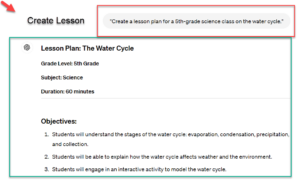
Create Quiz Questions
an AI quiz generator can generate multiple-choice questions that are both challenging and relevant, helping teachers assess student understanding effectively.
Prompt: “Generate 10 multiple-choice questions about the American Revolution for a 7th-grade history class.”
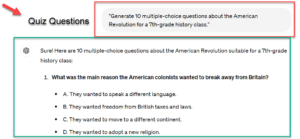
Summarize a Topic
Summarizing complex scientific topics in a simple, understandable manner is crucial for effective teaching. AI can provide clear and concise summaries suitable for different grade levels.
Prompt: “Provide a summary of photosynthesis suitable for a 9th-grade biology class.”

Develop Writing Prompts
AI can help create engaging and thought-provoking writing prompts that inspire students to think critically and creatively.
Prompt: “Create writing prompts for a high school English class on the theme of courage.”

Suggest Classroom Activities:
When you give a prompt to the Chatgpt, it will suggest the most significant classroom activities. It helps the individual growth of students.
Prompt: “Suggest engaging classroom activities for teaching fractions to 3rd graders.”

Translate Educational Material:
AI can help you the best if you try to use AI tools to translate text for any material that is written in a different language. This saves the time of teachers and helps them to teach more efficiently.
Prompt: “Translate this paragraph about the solar system into Spanish for my ESL students.”

Can AI Prompts Help with Classroom Management?
AI technology is revolutionizing various aspects of education, including classroom management. Here are some of the strategies I mentioned below;
Educators around the globe are exploring innovative ways to use AI in the classroom to enhance teaching methods and improve student engagement.
Among the advancements, tools designed to use AI tools for teachers to save time are gaining prominence due to their ability to automate mundane tasks, leaving teachers more time to focus on interactive and personalized teaching.
Furthermore, the educational sector is witnessing a significant transformation with the entry of major technology players. For instance, Google introduces new AI education tools, designed to streamline educational processes and foster an environment that encourages collaborative learning.
Meanwhile, a groundbreaking initiative by Khan Academy and Microsoft launch free Khanmigo AI assistant promises to redefine the educational experience by providing personalized learning paths for students.
In the backdrop of these advancements, it is crucial to understand the impact and effectiveness of these technologies in the realm of education.
To this end, exploring AI statistics in education can provide invaluable insights into how AI is being integrated into educational technology across the globe and its effects on teaching methodologies and student outcomes.
Through these explorations and implementations, educators are not only able to enhance classroom management but are also setting the stage for a future where technology and education merge to create an optimized learning environment for students worldwide.
Automating Repetitive Tasks:
AI-driven tools can handle grading, lesson planning, and administrative tasks, freeing up time for educators to focus on student interaction and instruction.
Prompt: “Generate a grading rubric for a high school English essay assignment.”

Personalizing Learning Experiences:
AI can analyze student data to create tailored learning experiences, offering personalized resources, adaptive assessments, and differentiated instruction.
This approach caters to individual student needs and improves academic performance.
Prompt: “Suggest personalized reading materials for a 5th-grade student struggling with comprehension.”
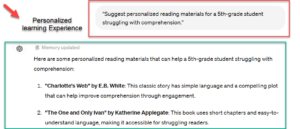
Enhancing Feedback and Engagement:
AI-powered writing tools provide instant feedback on assignments and assessments, helping students correct mistakes in real time and stay engaged with the material.
Prompt: “Provide instant feedback for a math problem set for 7th-grade students.”
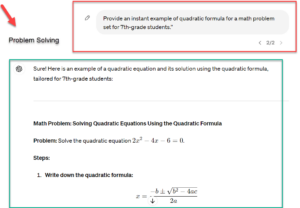
Decision Making:
AI systems collect and analyze data on student performance and engagement, enabling educators to make informed decisions, optimize teaching strategies, and implement targeted interventions.
Prompt: “Analyze student performance data to identify areas needing improvement in a middle school science class.”

Improving Communication:
AI can streamline communication among educators, students, and parents through automated emails and AI-powered platforms, ensuring timely and effective information sharing.
Prompt: “Generate an email template to inform parents about an upcoming parent-teacher conference.”

Supporting Behavioral Management:
Technologies like facial recognition and emotion detection help monitor student engagement and address distractions, reducing disruptive behavior and enhancing classroom focus.
Prompt: “Provide strategies to manage student disruptions using emotion detection tools.”
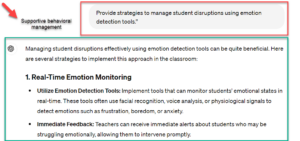
What are Some Common Mistakes to look out for while Creating AI Prompts for Teaching?
Creating AI prompts for teaching can be incredibly beneficial, but it’s easy to run into common pitfalls. Here are some of the mistakes to watch out for:
How Do AI Prompts Support Personalized Learning?
AI prompts for teachers are an invaluable tool for personalized learning, and I use this tool in every task.
Personalized learning has emerged as a transformative strategy in education, enabling teachers to cater to the individual learning styles and needs of each student.
With the advent of artificial intelligence (AI), the ability to tailor learning experiences has reached new heights. AI prompts, specifically designed for educators, leverage the power of AI to create dynamic learning environments that adapt to the abilities and interests of students.
One of the most exciting applications of AI in education is its potential to facilitate more efficient and effective studying strategies.
By use AI tools for studying, students can leverage tailored AI prompts that guide their exploration of new topics, reinforce their understanding through practice, and challenge them with problems designed to stretch their skills.
Furthermore, AI technology offers a compelling avenue for students and professionals alike to use AI tools to learn a new skill.
This approach harnesses the power of AI to personalize learning, making it possible to acquire new competencies more efficiently.
Through tailored content delivery and adaptive learning techniques, AI tools can significantly enhance the learning experience, making it more engaging and effective.
Here are examples of AI prompts for personalized learning.
For Personalized Study Plans:
AI tools create personalized study plans based on what a student knows and what they need to learn.
Interactive Practice Sessions:
Students can use AI to practice skills interactively, receiving immediate feedback. This makes learning more engaging and helps students understand concepts better.
Grammar and Writing Improvement:
AI analyzes writing and gives tips on grammar and style. Students get suggestions on how to improve their writing, making it clearer and more accurate.
Translation and Vocabulary Enhancement:
AI provides translations and explanations of phrases, helping students learn new languages. Students can expand their vocabulary by learning synonyms and seeing how words are used in different contexts.
Flashcard Creation:
AI generates flashcards with key vocabulary and concepts, making it easier for students to review and remember information. These flashcards are tailored to the student’s level and needs.
Examples of AI Prompts For Personalized Learning
- Individual Learning Plan:
“Create a customized learning plan for a student who struggles with math but excels in reading.”
- Skill Practice:
“Provide a series of practice problems for a student who needs help with fractions.”
- Progress Tracking:
“How can I track a student’s progress in reading comprehension over the semester?”
- Content Recommendation:
“Suggest activities for a student who enjoys science but finds history challenging.”
- Language Learning:
“Develop a vocabulary quiz for an intermediate French student focusing on travel-related words.”
- Behavioral Insights:
“What strategies can I use to help a student who is easily distracted during lessons?”
AI prompts for teachers are a valuable resource for creating personalized learning experiences. They help in designing lessons that cater to individual student needs, tracking progress, and providing interactive practice.
What Role Do AI Prompts Play in Assessing Student Performance?
AI prompts are transforming education by enhancing how student performance is assessed.
Teachers can gain deeper insights into student learning, identify areas for improvement, and provide personalized feedback more efficiently.
Personalized Feedback:
AI enables teachers to deliver individualized feedback based on detailed performance data for each student.
Automated Grading:
AI can quickly grade assignments and assessments, allowing teachers to focus on more impactful tasks.
Early Detection of Learning Gaps:
Teachers can address learning gaps before they escalate, ensuring timely support and intervention. AI analyzes performance data to identify struggling areas early on.
Adaptive Learning Paths:
This approach allows students to receive the necessary support to master concepts at their own pace.
Real-Time Insights:
AI provides real-time data on student performance, enabling teachers to adjust their strategies promptly.
Examples of AI Prompts For Assessing Student Performance
- Identify Improvement Areas: “Analyze the student’s recent test scores and identify areas where they need improvement.”
- Create Study Plans: “Design a study plan for a student who struggles with algebra but excels in geometry.”
- Recommend Activities: “Suggest activities for a student who shows interest in science but has difficulty with lab reports.”
- Progress Summaries: “Provide a summary of a student’s progress in writing skills over the past semester.”
How Can Teachers Use AI Prompts for Professional Development?
AI prompts can play a pivotal role in enhancing teachers’ professional development. I mentioned the key strategies for using AI prompts in professional development below.
Start with the Basics
Begin with understanding key concepts and terminology related to AI. Discuss common perceptions and provide clear explanations of what AI is and how it functions in everyday life.
Explore AI Applications
You can encourage experimentation with AI-driven educational applications to understand their capabilities and limitations.
Facilitate Collaboration
Create online learning communities where teachers can engage in ongoing conversations about AI integration, exchange resources, and provide mutual support.
Provide Continuous Support
Offer self-paced courses, webinars, and workshops focused on AI and its applications in education. AI prompts for teachers can guide teachers to relevant learning materials and track their progress.
Incorporate AI in Professional Development Events
You can participate in or organize conferences dedicated to AI in education. Use AI prompts to engage participants with thought-provoking questions and interactive sessions.
Examples of AI Prompts For Professional Development
- “What are the key components of artificial intelligence, and how are they applied in everyday life?”
- “Try using an AI tool like a chatbot or a grading assistant. Write a reflection on your experience and its potential benefits and challenges in your classroom.”
- “Research and summarize a case study where AI was successfully integrated into a classroom setting. What were the key outcomes and lessons learned?”
- In your next team meeting, discuss how AI could be used to support differentiated instruction in your subject area. Share your ideas and compile a list of potential strategies.”
Can AI Prompts Bring Creativity to Teaching?
AI prompts for teachers are revolutionizing education by enhancing creativity and engagement in the classroom.
I mentioned below that how can AI prompts can unleash creativity in teaching:
Defining the Role
Treat AI as a new participant in the classroom, assigning it specific roles such as a co-teacher, creative writing assistant, or math problem solver.
Providing a Task
Assign precise tasks to AI, such as generating quiz questions, offering personalized feedback, or creating interactive stories.
Giving Detailed Instructions
Break down tasks into manageable steps and use clear, simple language to provide instructions.
Setting Requirements
Establish clear expectations and boundaries for AI, such as the complexity of questions or creativity in stories.
Examples of AI Prompts Bring Creativity to Teaching
- Create a story starter for a creative writing exercise about a world where animals can talk. Make it engaging and imaginative to inspire students.”
- “Analyze this student’s essay on the impact of climate change and provide three personalized suggestions for improvement.”
- “Design an interactive project where students can learn about the water cycle through hands-on activities and digital simulations.”
- “Generate a series of math problems for 7th graders that involves real-life scenarios, like budgeting for a school event or planning a trip.”
- “Facilitate a classroom discussion on the ethical implications of AI in society. Provide thought-provoking questions to guide the conversation.”
What Are The Best Practices For Integrating AI Prompts In Teaching?
Here are the best practices for integrating AI prompts in teaching, which are beneficial for teachers and students.
Define Clear Objectives
Clearly outline what you aim to achieve with AI prompts for teachers. This helps in generating relevant and effective content tailored to your educational objectives.
Prompt: “Generate a lesson plan for B1 level students on the CEFR focusing on past tense irregular verbs. Include the lesson objectives, a warm-up activity, an explanation phase, a written practice task, and a role-play speaking exercise.”
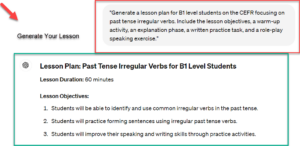
Provide Detailed Instructions
As a teacher, you should give AI precise and detailed instructions to ensure the output aligns with your needs.
Prompt: “Create a worksheet with fill-in-the-blank sentences focusing on present perfect tense for B2 students on the CEFR. Provide sentences, correct answers, and explanations in a table with three columns.”
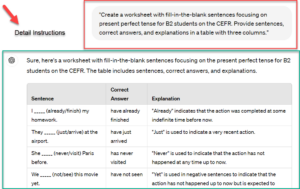
Review and Customize AI Output
Always review AI-generated content to ensure it meets your educational standards and aligns with your learning objectives.
Prompt: “Review my lesson plan below and suggest ways to make it more interactive for my students.
By following these best practices, teachers can effectively integrate AI prompts into their teaching. This approach saves time and leverages technology to enhance educational outcomes.
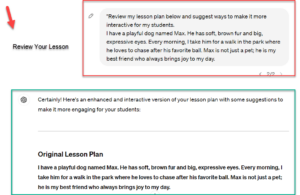
FAQs
How does AI help in teaching?
What is the best AI tool for teachers?
How can AI help in the classroom?
How can I use AI as a teacher?
Conclusion
Through my exploration of AI tools, I have seen AI can generate comprehensive lesson plans, create engaging activities, and offer instant feedback.
While AI is not a replacement for the human touch in teaching, it is an assistant that complements our expertise. Just like it has impacted other avenues like email marketing, business, marketing etc.
If you’re ready to transform your teaching methods, I suggest start experimenting with AI prompts for teachers today and see the difference!
Use AI to create lesson plans, automate grading, enhance engagement, monitor progress, and integrate AI-based learning tools. For a deeper understanding of will AI replace or assist teachers, explore our detailed exploration on the topic.





